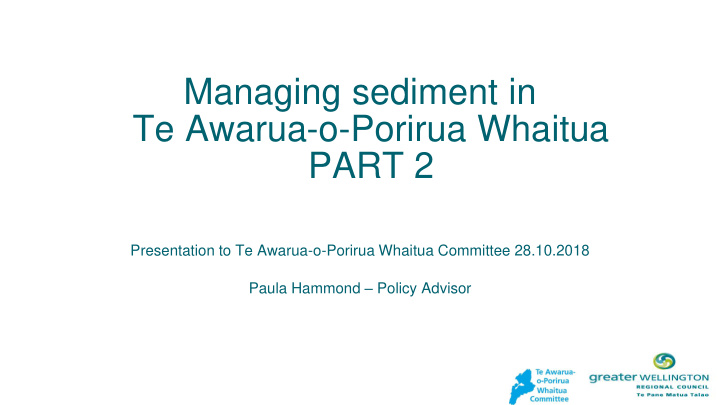



Managing sediment in Te Awarua-o-Porirua Whaitua PART 2 Presentation to Te Awarua-o-Porirua Whaitua Committee 28.10.2018 Paula Hammond – Policy Advisor
Recap of sediment objectives • Sedimentation rate objectives • Muddiness objectives
Sources of sediment • Earthworks • Forestry • Erosion prone land – today’s focus • Stream bank erosion – today’s focus
Sediment loads Total Load per WMU WMU name (t/yr) kg/ha Horokiri and Motukaraka 960 289 Pauatahanui Arm Kakaho Stream 250 200 Ration 200 289 Judgeford Stream 630 538 Pauatahanui 3210 767 Lower Duck Creek 530 513 Upper Duck Creek 380 716 Rangituhi Stream 30 356 Takapu Stream 650 843 Belmont Stream 270 582 Onepoto Arm Stebbings Stream 110 451 Kenepuru 820 649 Upper Kenepuru 530 1957 Porirua 2660 496 Hukarito Stream 10 102 Mahinawa Stream 40 158 Whiteria 10 102 Hongoeka to Pukerua 10 74 Open Coast Taupo Stream 90 80 Titahi 0 0
Sediment sources Current state Improved Water Sensitive % load from different erosion % load from different erosion % load from different Annual Annual Annual processes processes erosion processes average average average sediment Streamba sediment Landslid Streamban sediment Landslid Streamba WMU name load (t/yr) Hillslope Landslide nk load (t/yr) Hillslope e k load (t/yr) Hillslope e nk Pukerua 10 88% 9% 3% 6 89% 8% 3% 6 89% 8% 3% Hongoeka to Pukerua 10 88% 9% 3% 6 89% 8% 3% 6 89% 8% 3% Titahi 1 99% 0% 0% 1 99% 0% 0% 1 100% 0% 0% Taupo Stream 90 55% 25% 19% 52 73% 0% 27% 44 81% 0% 19% Horokiri and Motukaraka 960 31% 36% 33% 490 53% 20% 27% 465 55% 19% 26% Kakaho Stream 250 43% 41% 16% 90 88% 2% 9% 86 89% 2% 9% Ration Creek 200 91% 0% 9% 172 93% 0% 7% 170 93% 0% 7% Judgeford Stream 630 76% 13% 11% 504 86% 6% 8% 489 86% 6% 8% Pauatahanui Stream 3210 41% 6% 53% 2120 54% 3% 43% 1843 59% 3% 38% Lower Duck Creek 530 69% 26% 6% 238 91% 0% 6% 227 93% 0% 6% Upper Duck Creek 380 62% 35% 3% 154 94% 0% 1% 144 97% 0% 1% Hukarito Stream 10 100% 0% 0% 10 100% 0% 0% 10 100% 0% 0% Mahinawa Stream 40 92% 7% 1% 43 92% 7% 1% 42 92% 7% 1% Whitireia 10 100% 0% 0% 11 100% 0% 0% 11 100% 0% 0% Rangituhi Stream 30 98% 2% 0% 22 100% 0% 0% 22 100% 0% 0% Takapu Stream 650 42% 56% 1% 255 95% 4% 1% 228 99% 0% 1% Belmont Stream 270 76% 23% 0% 111 88% 11% 1% 114 89% 10% 0% Stebbings Stream 110 99% 0% 1% 58 100% 0% 0% 59 100% 0% 0% Upper Kenepuru 530 22% 78% 0% 89 86% 13% 0% 89 86% 13% 0% Kenepuru 820 48% 50% 2% 245 88% 5% 5% 239 89% 5% 4% Porirua 2660 59% 32% 9% 1400 80% 3% 16% 1335 82% 3% 15%
Erosion prone land Current policy direction • GWRC earthworks and vegetation clearance permitted rules • GWRC policies to minimise risk of accelerated soil erosion and control silt and sediment runoff • WCC and PCC slope restrictions on permitted earthworks rules
Erosion prone land recommendations (s4.5 Pg 28) 1. Greater Wellington uses existing land classifications (e.g. The NES-PF Erosion Susceptibility Classification or Land Use Classification (LUC)) to identify, at a broad scale, priority areas for reducing sediment. Once priority areas have been identified, work with affected land owners to develop farm management plans that address how sediment losses will be reduced at a farm/property scale. Should this recommendation apply across the whole whaitua, or just in the ‘top five’ sediment producing WMU? 2. Greater Wellington undertakes work to refine identification and classification tools for erosion prone land. The tool is then used to identify priority areas for retirement in the Whaitua within the next 10 years. 3. Greater Wellington aligns the planning, funding and support of sediment mitigation activities, including both riparian restoration and hill slope erosion with the identified priority areas. 4. Greater Wellington improves resources in the whaitua to provide land management advice to rural land owners. 5. Greater Wellington prioritises opportunities to retire grazing lands in their regional parks in the whaitua.
Stream bank erosion Current policy direction – Stock access to the bed of streams is a permitted activity within the Whaitua – Riparian planting programmes supported by GWRC
Stream bank erosion recommendation (s4.5 Pg 28) 1. Greater Wellington explores options for bank protection works with the intention of making the consent process easier where the works are undertaken to actively reduce stream bank erosion. Stream stock exclusion recommendation (s4.5 Pg 29) 1. Greater Wellington develops a new rule that ensures stock are excluded from waterbodies where the surrounding land has a slope of less than 15 degrees. i.e. fencing or planting may be unsuitable/unfeasible on steeper land.
Recommend
More recommend